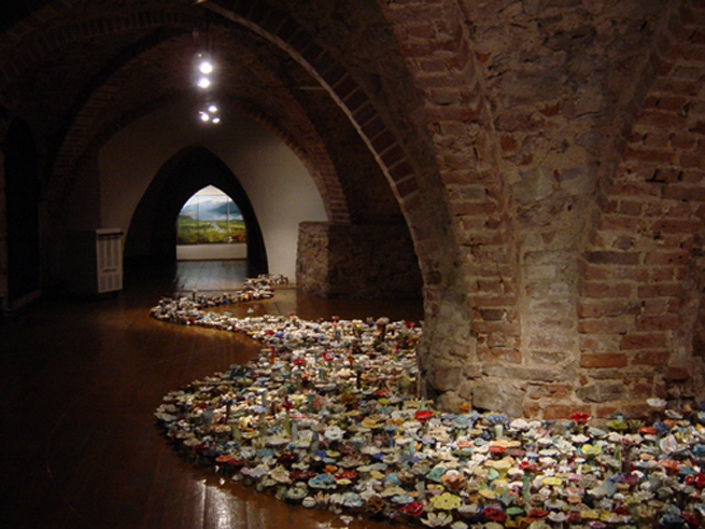The artist group Flora Metamorphicae has chosen a descriptive name. They are working with flowers and transformation. Not only a thematic transformation of flowers as a theme, but also an exceeding, esthetic transformation of the conventional framework of ceramics. The first is about form and the use of symbols. The other is about a transformation of well-established forms of expressions. Both implicate testing of different forms of exhibition and exhibition environments. This testing is done both inside and outside of the traditional art gallery.
Both in motive and material Flora Metamorphicae's ceramic flowers are charged with a traditional symbolism connected to nature's cyclic rhythm - from conception and birth to death and decay. People started quite early to decorate jars and vessels with simple flower motives, but it was not until the epoch-making production of porcelain and faience in the 15th century that flower decorated ceramics started playing a prominent part in Western art and design history. In this context we may interpret Flora Metamorphicae's project as a challenge to tradition. They hold on to the basic elements - clay, flowers and their inherent symbolism - but they also let the individual components undergo a transformation. The flowers don't only appear as painted decor while the clay - or the vessel - plays the part as canvas. The flowers themselves are the motives, both as form and content, picture and sculpture.
It is a common view that the most complete conceptual art experience is connected to the vague passage between representation and reality. The artist and theoretic Joseph Kosuth (b. 1945) wished to reveal the characteristics of the chair as a chair - its so called "chairness" - with his work of art One and Three Chairs (1965). By exhibiting an ordinary chair, a photo of a chair and a copy of the lexical definition of the word "chair" he wanted to express the idea chair as the real work of art. Through Kosuth's move from the concrete to the abstract, from reality to conceptions, the viewer was involved in the work of art in an unreserved and direct way, but he had to find meaning in the underlying structures himself. Similar mechanisms are triggered when Flora Metamorphicae lavish their ceramic flowers. By placing one or several flowers in strange environments they both explore the complex relations between nature and culture and the mutual dependence between site, work of art and viewer. The unexpected meetings trigger social processes and an entirely new consciousness of the sites' backgrounds and symbolic values.
With the project "Flora i fjæra" ("Flora at ebb and flow") Flora Metamorphicae's explorations found its most expressive form. Under the land art exhibition "Spor i landskap" on Tyssøy (2005) several hundred ceramic flowers were placed on a small beach. The site was chosen with great care in regard to the ebb and flow. The purpose of this installation was to show how the impression of the flowers changed with the tides, the weather and the light. At high tide the sea water covered the flowers completely, and at low tide the flowers dried among stones, shells and seaweeds. Between these extremes the water played around the petals. The viewer continually could se new, procedural elements in this work of arts that was constantly changeable.
Flora Metamorphicae's interest in different environments have evident precursor in the 1970's land of art. The sculptor Robert Smithson (1938-73) was an initiator here. He created objects of art at outlying places and incorporated geological and physical processes in the works of art so it became part of an even greater process; nature itself, dependent on erosion, destruction and entropy. Smithson made a point of operating at almost inaccessible places - or sites - but he didn't quite succeed in emancipating himself from the fixed framework of the galleries. By means of so-called non-sites, photo documentation, film and other means of expression, he brought the site specific works of art back into the traditional gallery. Here the viewer could reconstruct the works of art conceptually, something that placed the art in a new and challenging position; somewhere between physical presence and actual absence.
We see similar outlines in Flora Metamorphicae's project. As Smithson presumed on the dialectics between sites and non-sites Flora Metamorphicae presume on the flowers' return to the gallery. When Krypten at Hordaland Kunstsenter are filled with a flora of colorful ceramics, the flowers bring with them rust and grains of sand on their petals. The flowers have been roaming, and now they return to the well-known sphere of the gallery. The inconstant is manifested. The viewer experiences both the present and the past. Flora Metamorphicae themselves prove to be changeable and to have changeable intentions - in the service of flowers and art.
By art historian Mai Lahn-Johannessen, eloenne@online.no
Translated by Lene Stokseth, lene@stokseth.no
|


